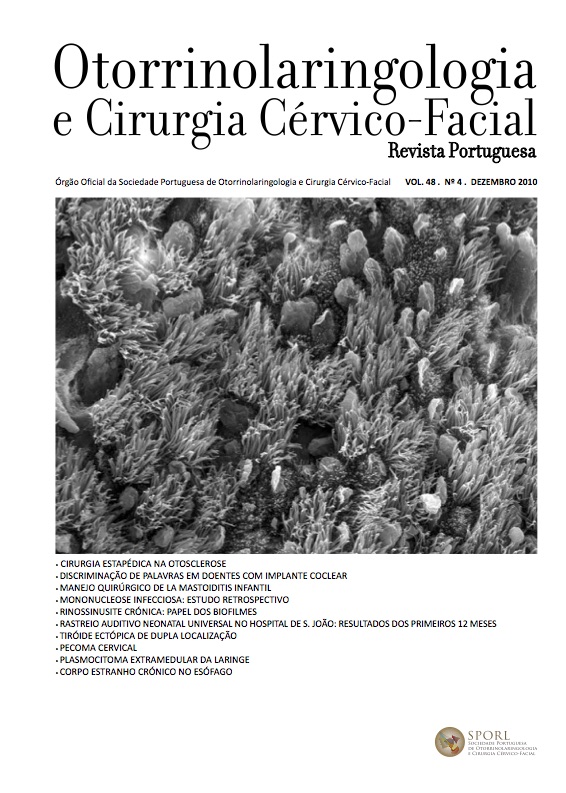Infectious mononucleosis: retrospective study
DOI:
https://doi.org/10.34631/sporl.211Keywords:
infectious mononucleosis, admission, complicationsAbstract
Introduction: Infectious mononucleosis is a disease caused by Epstein Barr virus and has diverse clinical manifestations. In children it is usually asymptomatic whereas in adolescents and adults it classically appears with fever, pharyngitis and lymphadenopathy. Although typically self-limited, occasionally it can complicate with a wide variety of neurologic, hematologic, hepatic, respiratory and psychological symptoms that can lead to hospital admission.
Materials and Methods: Retrospective review of clinical charts of patients admitted with infectious mononucleosis diagnosis between 2000 and 2009 in order to assess symptoms, physical findings examination, laboratory data and treatment.
Results: Clinical charts of 87 patients admitted with infectious mononucleosis were analyzed. The majority of them were previously healthy patients with a mean age 12,6 years. The most common symptoms were fever, odynophagia and lymphadenopaty. The most frequent reason for admission were severe odynophagia and hepatitis/splenomegaly. Treatment was essentially supportive.
Conclusions: Infectious mononucleosis is usually a benign selflimited disease that in certain cases can become complicated with a variety of symptoms and needs to be treated in a hospital setting.
Downloads
References
– Jenson H. Acute Complications of Epstein-Barr Virus Infectious Mononucleosis. Current Opinion in Pediatrics; 2000; 12:263-268
– Bennett N. Mononucleosis and Epstein-Barr Virus Infection. www.emedicine.com/ped/topic705.htm
– Macsween K, Crawford D. Epstein-Barr Virus – Recent Advances. Lancet Infect Dis;2003; 3:131-40
– Lumio J, Karjalainen S. Patients Treated in Hospital for Infectious Mononucleosis and Risk of Cancer. Scand J Infect Dis. 1993; 25:283-288
- Derkay C, Bramhall T. Epstein-Barr Viral Infectious Mononucleosis. Otolaryngol Head Neck Surg. 1995; 113:334-337
– Cohen J. Epstein-Barr Virus Infection. N Eng J Med; 2000. 343:481-492
– Rea T, Buchwald D. Prospective Study of the Natural History of Infectious Mononucleosis Caused by Epstein-Barr Virus. J Am Board Fam
Pract. 2001; 14:234-242
– Tattevin P, Michelet C. Increasing Incidence of Severe Epstein-Barr Virus-related infectious Mononucleosis: Surveillance Study. J Clin Microbiol. 2006; 44:1873-1874
– Field P, Dwyer D. Difficulties with the Serologic Diagnosis of Infectious Mononucleosis: a Review of the RCPA Quality Assurance Programs. Pathology. 1996; 28:270-276
– Seitanidis B. A Comparison of he Monospot With tha Paul-Bunnell Test in Infectious Mononucleosis and Other Diseases. J Clin Path. 1969;22:321-323
– Pitetti R, Wadowsky R. Clinical Evaluation of a Quantitative Real Time Polymerase Chain Reaction Assay for Diagnosis of Primary Epstein-Barr Virus Infection in Children. Pediatr Infect Dis J. 2003: 22:736-739
– Glynn F, Kinsella J. Upper Airway Obstruction in Infectious Mononucleosis. European J Emerg Med. 2007; 14:41-42
– Irving J, Taylor G. Florid Infectious Mononucleosis: Clinicopathological Correlation in Acute Tonsillectomy. Int J Pediatr Otolaryngol. 2002; 66:87-92
– Kumar R, Wathen L, Validation of the health-related Productivity Questionnaire Diary (HRPQ-D) on a Sample of Patients with Infectious Mononucleosis: Results from a Phase 1 Multicenter Clinical Trial. J Occup Environ Med. 2003; 45:899-907
- Petersen I, White P. Risk and Predictors of Fatigue after Infectious Monunucleosis in a Large Primary-care Cohort. Q J Med. 2006; 99:49-55
- Posthuma E, Lamers C. Fatal Infectious Mononucleosis: a Severe Complication in the Treatment of Crohn’s Disease with Azathioprine.
Gut. 1995; 36:311-313
– Lindemann T, Greene S. Persistent Cervical Lymphadenopathy in an Adolescent with Epstein-Barr Induced Hemophagocytic Syndrome: Manifestations of a Rare but Often Fatal Disease. Int J Pediat Otolaryngol. 2005; 69:1011-1014
– Gershburg E, Pagano J. Epstein-Barr Virus Infections: Prospects for Treatment. J Antimicrob Chem. 2005; 56:277-281
– Thompson S, Hengerer A. Infectious Mononucleosis and Corticosteroids. Arch Otolaryngol Head Neck Surg. 2005; 131:900-904
– Ganzel T, Padhya T. Otolaryngologic Clinical Patterns in Pediatric Infectious Mononucleosis. Am J Otolaryngol. 1996; 17:397-400






